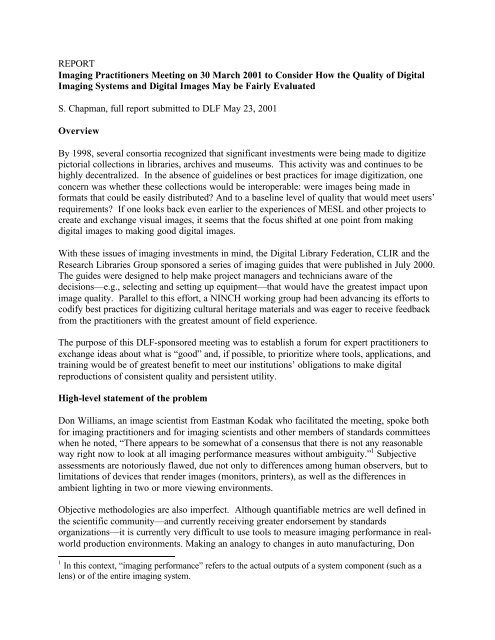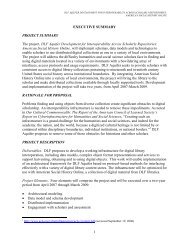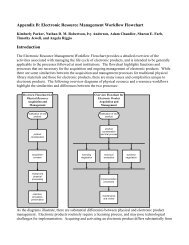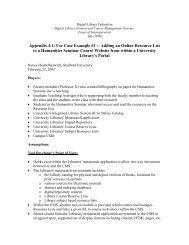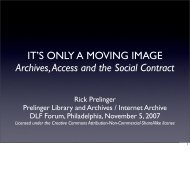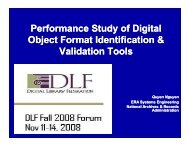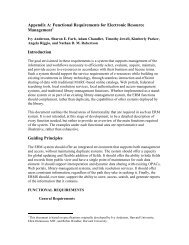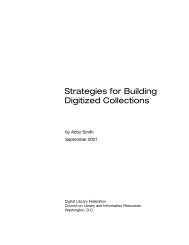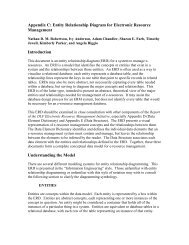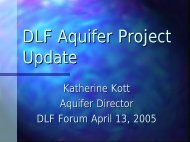summary - Digital Library Federation
summary - Digital Library Federation
summary - Digital Library Federation
You also want an ePaper? Increase the reach of your titles
YUMPU automatically turns print PDFs into web optimized ePapers that Google loves.
REPORT<br />
Imaging Practitioners Meeting on 30 March 2001 to Consider How the Quality of <strong>Digital</strong><br />
Imaging Systems and <strong>Digital</strong> Images May be Fairly Evaluated<br />
S. Chapman, full report submitted to DLF May 23, 2001<br />
Overview<br />
By 1998, several consortia recognized that significant investments were being made to digitize<br />
pictorial collections in libraries, archives and museums. This activity was and continues to be<br />
highly decentralized. In the absence of guidelines or best practices for image digitization, one<br />
concern was whether these collections would be interoperable: were images being made in<br />
formats that could be easily distributed? And to a baseline level of quality that would meet users’<br />
requirements? If one looks back even earlier to the experiences of MESL and other projects to<br />
create and exchange visual images, it seems that the focus shifted at one point from making<br />
digital images to making good digital images.<br />
With these issues of imaging investments in mind, the <strong>Digital</strong> <strong>Library</strong> <strong>Federation</strong>, CLIR and the<br />
Research Libraries Group sponsored a series of imaging guides that were published in July 2000.<br />
The guides were designed to help make project managers and technicians aware of the<br />
decisions—e.g., selecting and setting up equipment—that would have the greatest impact upon<br />
image quality. Parallel to this effort, a NINCH working group had been advancing its efforts to<br />
codify best practices for digitizing cultural heritage materials and was eager to receive feedback<br />
from the practitioners with the greatest amount of field experience.<br />
The purpose of this DLF-sponsored meeting was to establish a forum for expert practitioners to<br />
exchange ideas about what is “good” and, if possible, to prioritize where tools, applications, and<br />
training would be of greatest benefit to meet our institutions’ obligations to make digital<br />
reproductions of consistent quality and persistent utility.<br />
High-level statement of the problem<br />
Don Williams, an image scientist from Eastman Kodak who facilitated the meeting, spoke both<br />
for imaging practitioners and for imaging scientists and other members of standards committees<br />
when he noted, “There appears to be somewhat of a consensus that there is not any reasonable<br />
way right now to look at all imaging performance measures without ambiguity.” 1 Subjective<br />
assessments are notoriously flawed, due not only to differences among human observers, but to<br />
limitations of devices that render images (monitors, printers), as well as the differences in<br />
ambient lighting in two or more viewing environments.<br />
Objective methodologies are also imperfect. Although quantifiable metrics are well defined in<br />
the scientific community—and currently receiving greater endorsement by standards<br />
organizations—it is currently very difficult to use tools to measure imaging performance in realworld<br />
production environments. Making an analogy to changes in auto manufacturing, Don<br />
1 In this context, “imaging performance” refers to the actual outputs of a system component (such as a<br />
lens) or of the entire imaging system.
pointed out that photographers no longer know “what’s under the hood” in their imaging<br />
systems. It is difficult enough to find tools to interrogate imaging performance—in key areas<br />
such as noise, density and dynamic range—but even more problematic to subtract the errors that<br />
may have been inadvertently introduced by the process itself. Does a noise measurement, for<br />
example, refer to the imaging system or the noise generated by a target that was digitized?<br />
Intentional or unintentional use of imprecise terminology also creates ambiguity. For example,<br />
industry’s marketing literature and our community’s funding guidelines routinely associate<br />
image quality with unreliable metrics—such as resolution and bit depth. These performance<br />
characteristics refer to input settings and become ambiguous if used to describe output quality.<br />
The same source could be digitized by two systems that produce the same nominal results (e.g,<br />
3,000 pixel, 24-bit RGB images) yet the quality of the images may differ significantly.<br />
Finally, as Ron Murray would point out at the meeting, there is a potential to confuse<br />
measurements with judgments (how people see images and whether they will be satisfied). The<br />
challenge is to integrate these two perspectives of quality into methods for quality control.<br />
Several challenges brought imaging experts to this forum: to improve upon the conventions used<br />
to describe and distinguish the performance of various imaging systems; to institutionalize<br />
methods to monitor performance of equipment; and to simplify the task of evaluating images,<br />
particularly those produced outside of known workflows.<br />
Meeting Discussion and Outcomes<br />
Twenty-one participants representing two commercial, four museum, and five library/archives<br />
studios attended the meeting. Despite the differences in institutional missions, client demands,<br />
and characteristics of source materials, the photographers and production managers identified a<br />
number of common practices and common challenges to digitizing historic materials. The<br />
meeting established without question that there is a single community of expert practitioners who<br />
benefit from opportunities to exchange ideas, share knowledge, and collaborate to refine<br />
practice.<br />
Much of the discussion focused on what Don Williams referred to as “key performance metrics”<br />
to judge the quality of imaging systems (both hardware and software). The photographers<br />
largely agreed with these metrics in principle, but identified a number of limitations to<br />
implementing them in practice. Despite the prevalence of targets (grayscales and color bars) to<br />
anchor image quality and image processing, this practice receives only a qualified endorsement.<br />
In short, experts pointed out the key dependencies that must be addressed when applying key<br />
metrics. The major ones include: requirements to manufacture targets of materials similar to the<br />
artwork being photographed; regular instrument calibration, including redundant measurements;<br />
education and training; and development of software that is easy to use in a production<br />
environment.<br />
The group agreed unanimously to move ahead on several fronts, with the expectation that each<br />
activity will develop necessary foundations for information exchange, standards development,<br />
and testing to precede application development.
Action will be taken to:<br />
• establish a listserv (dlf-image) for imaging practitioners working with historic materials<br />
• undertake a collaborative experiment to determine whether ISO 16067-sanctioned tools<br />
(slanted-edge target and Auto SFR software) work in a variety of production environments<br />
• liaise with ISO standards committees: draft a letter informing committees of the volume of<br />
(non-consumer based) work being done in our community and the obstacles that need to be<br />
overcome for reliable image exchange<br />
• collaborate to draft requirements for—or perhaps even develop—targets of materials<br />
(spectral response, contrast, size) similar to the historic materials we are asked to digitize<br />
• meet again, pending support, at the Art Institute of Chicago in the fall<br />
List of Participants<br />
Sally Bjork<br />
Photographer<br />
University of Michigan<br />
734-647-9989<br />
sbjork@umich.edu<br />
Steve Chapman<br />
Preservation Librarian for <strong>Digital</strong> Initiatives<br />
Harvard University <strong>Library</strong><br />
617-495-8596<br />
stephen_chapman@harvard.edu<br />
Bill Comstock<br />
Manager, <strong>Digital</strong> Imaging Group<br />
and Photography Studio<br />
Harvard College <strong>Library</strong><br />
617-496-5241<br />
comstock@fas.harvard.edu<br />
Franziska Frey<br />
Research Scientist<br />
Image Permanence Institute<br />
716-475-2302<br />
fsfpph@rit.edu<br />
Hans Hansen<br />
Chief Technology Officer<br />
Octavo<br />
510-251-6033<br />
hansen@octavo.com<br />
Dan Johnston<br />
Senior Photographer (and manager)<br />
University of California, Berkeley<br />
510-643-9314<br />
djohnsto@library.berkeley.edu<br />
Erik Landsberg<br />
Senior Fine Art Photographer (and manager)<br />
Museum of Modern Art<br />
212-708-9489<br />
erik_landsberg@moma.org<br />
Lee Mandell<br />
Programmer/Analyst<br />
Harvard University <strong>Library</strong><br />
617-495-3724<br />
mandell@fas.harvard.edu<br />
David Mathews<br />
Photographer<br />
Museum of Fine Arts, Boston<br />
617-267-9300<br />
dmathews@mfa.org<br />
Jan Merrill-Oldham<br />
Malloy-Rabinowitz Preservation Librarian<br />
Harvard University <strong>Library</strong><br />
617-495-7657<br />
jmo@harvard.edu
Phil Michel<br />
<strong>Digital</strong> Conversion Specialist (and manager)<br />
<strong>Library</strong> of Congress Prints & Photographs<br />
202-707-8917<br />
pmic@loc.gov<br />
Stephanie Mitchell<br />
Photographer<br />
Harvard College <strong>Library</strong><br />
617-496-9346<br />
stephanie_mitchell@harvard.edu<br />
Ron Murray<br />
Scientific Photographer, Librarian<br />
<strong>Library</strong> of Congress Preservation Directorate<br />
202-707-9610<br />
rmur@loc.gov<br />
Alan Newman<br />
Executive Director, Imaging Dept.<br />
Art Institute of Chicago<br />
312- 443-7247<br />
anewman@artic.edu<br />
Steve Puglia<br />
Preservation and Imaging Specialist<br />
National Archives and Records Admin.<br />
301-713-6712<br />
steven.puglia@arch2.nara.gov<br />
David Remington<br />
Photographer<br />
Harvard College <strong>Library</strong><br />
617-496-9346<br />
remingt@fas.harvard.edu<br />
Mark Roosa<br />
Director for Preservation<br />
<strong>Library</strong> of Congress<br />
202-707-7423<br />
mroo@loc.gov<br />
David Semperger<br />
Project Manager<br />
Boston Photo, Inc.<br />
617-267-4086<br />
dsemp@bostonphoto.com<br />
Peter Siegel<br />
Manager, <strong>Digital</strong> Imaging and Photography<br />
Harvard University Art Museums/<br />
Harvard Fine Arts <strong>Library</strong><br />
617-495-4846<br />
siegel@fas.harvard.edu<br />
Don Williams<br />
Imaging Scientist<br />
Eastman Kodak Company<br />
Imaging Research and Development<br />
716-477-7446<br />
wilyums@rochester.rr.com<br />
John Woolf<br />
<strong>Digital</strong> Imaging Specialist (and manager)<br />
Museum of Fine Arts, Boston<br />
617-267-9300<br />
jwoolf@mfa.org


